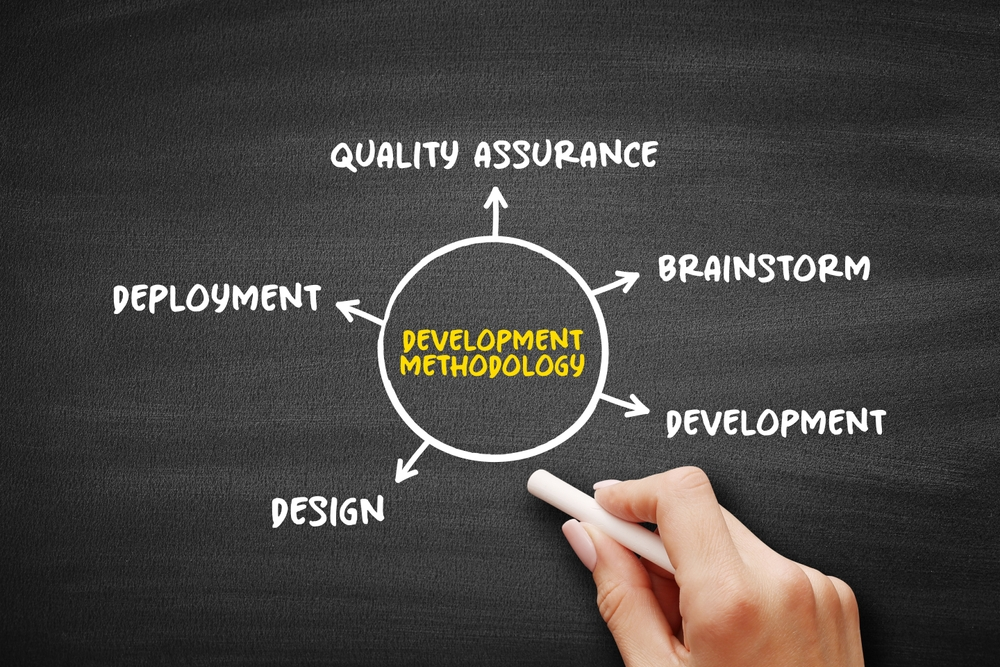If you’re exploring the Agile development process, grasping the 5 agile development stages is crucial for effective implementation. The agile software development lifecycle stands as a flexible and iterative process that contrasts with the traditional Waterfall model, emphasizing its adaptability to change and quicker delivery of working software. These stages form the backbone of Agile projects, ensuring they progress from conception to deployment in a flexible yet structured manner. In this guide, we’ll take you through each of these stages—planning, iterative development, quality assurance, deployment, and maintenance—clarifying the key activities and goals within each phase to help you understand how they fit together into a cohesive Agile practice.
Key Takeaways
- Agile software development revolutionized the software industry with its emphasis on flexibility, iterative cycles, and the Agile Manifesto, which prioritizes individuals, interactions, and adaptive planning.
- The Agile development cycle is structured into five key stages: Project Initiation and Planning, Iterative Development, Quality Assurance and Testing, Deployment and Release, and Ongoing Support and Maintenance, each integral to the software’s functionality and quality.
- Best practices for successful Agile development include fostering teamwork, ensuring continuous improvement, and adapting to change, all supported by Agile tools for project management, collaboration, and automation like Jira, Slack, and Jenkins.
Understanding Agile Software Development
The need for more agility and flexibility has turned agile software development into a major power in the industry. Its deviation from conventional approach towards an iterative process instead of a rigid sequential steps. The Agile Manifesto acts as a set of guiding principles and values that foster teamwork, flexibility, and continuous improvement.
At the same time, different agile methodologies bring different realization patterns of these principles within the teams. All these approaches accept agile’s fundamental principles while providing specific adaptation strategies for various circumstances, thereby making the concept of continual improvement the focus of agile development endeavors.
The Agile Manifesto
At the heart of Agile software development lies the Agile Manifesto – a beacon guiding software development teams towards four fundamental principles.
- Individuals & Interactions
- Working Software
- Customer Collaboration
- Responding to Change
The emphasis is on individuals and interactions over processes and tools, suggesting that effective communication and collaboration are the backbone of successful Agile development.
Furthermore, the Agile Manifesto prioritizes working software as the primary measure of progress, underscoring the essence of being able to deliver working software consistently, ensuring it is functional and usable.
Agile Methodologies Overview
Agile is an adaptable model of software development that does not have an exact methodology. It does not, however, present, but a range of approaches with each having its peculiarities. For example, the Scrum is one of the Agile project management frameworks, which concentrates on making incremental developments in the two- to four-week iterations. For instance, Kanban that gives preference to continuous improvement through flexible task management and optimized workflow is another example.
In order to agile methodologies to work effectively in projects, proper alignment should exist between the particular requirements of the project, the capacities of the team implementing the project, and the goals set by the organization. This ensures a customized approach in the software development process meeting the needs of every individual.
The 5 Key Stages of Agile Development
Software development process follows a structured way that is called the agile life cycle. It has five principal stages, and it is not a haphazard trip. These phases are generally known as the agile development cycle. In the first phase, projects are initiated and planned by the team, features are weighted based on their relative importance and the scope is defined. This causes iterative development to occur through cycles known as sprints.
The implementation stage typically involves deployment or release which is testing in quality assurance following design and coding stages alongside requirements gathering and planning making up a normal software development life cycle. Then, support by continuous maintenance of this developed application is necessary.
To guarantee productive use of every software product, the correct implementation of each of these processes steps is of utmost importance. For example, during the first steps, a clear plan together with deep analysis leads to successful accomplishment. Further, critical appraisal during iteration results to flexibility, future modification possibilities and general user satisfaction. Therefore, it is safe to say that the systematic approach during all stages will produce the right outcomes and an excellent end product with smooth functioning.
Stage 1: Project Initiation and Planning
The stage of project initiation and planning is the starting point in setting up a foundation for an Agile journey. This means that the project scope is defined by top-level requirements, usually in the form of User Stories. In this stage, features are ranked using techniques such as MoSCoW (Must-haves, Should-haves, Could-haves, and Won’t-haves).
Simultaneously, the building of the software development team is being organized under the supervising of the ScrumMaster to maintain the Agile principles. The whole team, including product owners, works together to help manage the product backlog, and to communicate vision and roadmap alignment from the beginning to the end of the software development process.
Stage 2: Iterative Development
The second phase of development looks also like iterative development stage and implies the start of activity in the software building process. This consists of multiple cycle or sprints of 1-2 weeks durations each as this includes sprint planning, designing and coding, and in the end testing.
This approach leads to constant incrementally improved product that can be shipped at any point in these iterations. Continuously looking for feedback and adjusting upon the feedback and user needs and market conditions all through this process ensures that the project stays on track with its intended use.
Stage 3: Quality Assurance and Testing
At the phase of quality assurance and testing, software development teams validate their product before its release. This stage is about performing detailed test to determine both the functionality and quality of the software.
Key characteristics of this stage are early participation in collectively identifying issues, agile test strategies, iterative testing approaches, automation of repetitive and regression tests, frequent code reviews, little documentation with an emphasis on teamwork and user needs. The team, therefore, ensures functionality and adherence to high-quality standards throughout the whole process to improve the overall success of the entire software development process.
Stage 4: Deployment and Release
In deployment and release phase, the software is put into practice. It can be hosted on a cloud or on premise server for users to access it. The integration phase is all about making the software a harmless part of the company with strategies executed during its Agile deployment process. The purpose is to have a seamless transition with little to no disruptions in this critical stage.
Appreciating the importance of this step, agile practices stress on carefully aligning all systems before the official release of a software to production.
Stage 5: Ongoing Support and Maintenance
The software doesn’t mean the end of the journey. The last phase, called ongoing support and maintenance, is about customer feedback and changing demands. This encompasses the correction of any software weaknesses, improvement of the current features, and regular system maintenance.
This phase includes being aware of changing requirements and quick reaction to customers’ needs as well as following market tendencies. It calls for sticking with an important principle of providing quality products that are relative to customers, and in the process, they consistently meet with their expectations.
Agile Development Best Practices
Agile development is a journey but it can be steered by adhering to some best practices. Other factors are the need for teamwork and communication among the team members, consistent effort to improve, and flexibility possessed during the whole project.
Agile emphasizes the significance of:
- Working closely with customers
- Ensuring customer satisfaction
- Regularly delivering functional software
- Maintaining flexibility in project management approaches
Collaboration and Communication
Collaboration and communication are critical aspects of Agile development as opposed to just good practices. These actions make sure that the team operates with one mindset, stimulate information exchange among team members, and help in the creation of informed decision. By not making common mistakes such as absence of face-to-face communication, lack of roles and responsibilities, or improper use of communication tools.
- It is important to prioritize face-to-face discussions.
- Clarify roles clearly beforehand.
- Effectively utilize available communication resources.
Continuous Improvement
Agile development system has the improving aspect, improving may mean trying to enhance team performance and software quality. This method is based on the constant revision of instruments, procedures, and instruments that assure the realization of the best result.
This way also considers continuous team performance evaluations to single out certain areas which need to be sharpened and improved. Secondly, when the opportunities have been identified by the analysis, minor changes are made to both processes and products. The primary aim is development of growth culture in teams, thus increasing productivity and creativity.
Adapting to Change
The success of agile development relies on its ability to embrace change. Agile teams understand the importance of being receptive to new ideas, requirements, and feedback. They recognize that their agility in adjusting plans and priorities is crucial for:
- Delivering a top-notch product
- Catering to ever-changing customer needs
- Continuously enhancing their processes
- Responding promptly to shifts in the market
To effectively adapt to change, some effective strategies include:
- Encouraging regular exchanges of feedback between team members
- Clearly conveying the vision and values underlying agile principles
- Engaging stakeholders in discussions regarding priorities as well as potential trade-offs.
Further Reading: Mastering Agile Methodologies: Ultimate Guide To Transformative Project Management
Agile Development Tools and Techniques
The successful passing the Agile journey demands collection of tools and training methods. Such tools consist of project management, collaboration, and automation systems that aid in successful project management, efficient collaboration, and process automation to increase productivity and uniformity. Typical examples in these areas are Jira or Trello in project management, Slack or Microsoft Teams for collaboration, and Jenkins or GitLab in the area of automation with continuous integration/deployment (CI/CD).
Project Management Tools
Project management tools act as a rudder of Agile teams, which navigates them in their course. Among the most popular examples of tools that are used for agile project planning, management, and control are Jira, Trello & MS Project. They perform numerous functions that include task boards, backlog arrangement, and reporting feature that promote coordination and team effort among the members.
These essential instruments enable agile teams to control tasks effectively and, as a result, track the development of the provision of high quality software results.
Further Reading: Best Alternatives Of Microsoft Project: For Streamlined Project Management In 2024
Collaboration Tools
The tools used in abetting are the children of agile teams. Such software as Slack and Microsoft Teams provide all the features of the real-time communication, file sharing and integration with other tools, which are necessary to support Agile workflow. These tools foster a never-ending team work and live response among team members, as a result of which a high adaptability level grows within the team dynamic. This facilitates live participation of people in information exchange, solving problems, and collective decisions.
Automation and CI/CD
Jenkins and GitLab play a major role in the Agile development cycle since they automate vital processes including code integration, testing, and deployment. Such simplifications make the process more efficient and enable the code to be continuously integrated and delivered. This cuts feedback loops to make quick adjustments, promotes close collaboration between software development teams, and increasing software quality by continuously modifying the test code during each of the product development phase.
Challenges and Solutions in Agile Development
The advantages of the Agile development were discussed in this paper, as well as the challenges associated with it, which include finding the right balance between flexibility and structure, satisfying the needs of the stakeholders, and integrating agile practices across the organization. However, these challenges can be overcome through the application of effective methods and the use of best practices with the flexibility and adaptability which agile development inherently possesses.
Balancing Flexibility and Structure
The main problem of implementing Agile principles is to come to a balance between flexibility and at the same time organization. To succeed, an agile team has to strike the balance between adjusting to new circumstances and yet keeping the firm project vision and plan. To do this you need to quickly adapt to changes in what the customer wants, what the requirements are, what the market is demanding, all the time being focused on delivering results of high value.
Managing Stakeholder Expectations
Satisfying stakeholder expectations can become a major problem in Agile development. To address this, agile teams need to set achievable goals, practice open communication and demonstrate progress by delivering product increments frequently and conducting reviews. The Agile methodology implementation provides methods of managing such expectations which include regular delivery of value, ongoing demonstration of accomplishments and active engagement of stakeholders to ensure that they understand the project goals and priorities.
Scaling Agile Across the Organization
Implementing Agile in an entire organization is a great challenge. It requires each team, department, and project to have a practical realization of the principles and methods. Using proper techniques and resources will help in the scaling of Agile to achieve strategic objectives and generate outcomes all over the organization.
Summary
Agile development is a contemporary and adaptive approach to software creation that is based more on iteration. Collaboration, adaptability, and continual improvement are some of its main traits that lead to successful production of top quality products. Similar to most journeys in life, development of agile systems comes with a number of challenges that can be addressed by adherence to proper tools and best practices through effective strategies.
Using this strategy in supporting others, we have a well-coordinated approach. The agile methodology organizations enjoy considerable benefits while maneuvering through the rapidly changing world of software creation. It is crucial to realize that aside from being just a procedure. Agility is a creative spirit that strives to provide value via constant evolution.
Frequently Asked Questions
What is the step 5 for implementing Agile?
Step 5 in the Agile implementation process includes rapid feedback loops that are the core learning and adapting enablers for project success. Interactions are an important part of successful management of a project in an Agile setting.
It is useful to mention that quick feedback cycles are highly valued in project management using the principles of Agile methodology. Through continuous searching and following.
What are the 5 stages in the development life cycle Scrum?
The development life cycle of Scrum consists of 5 stages: initiation, planning and estimation, implementation, review and retrospective, and release. In an agile environment, these stages are extremely important for successful delivery of a project. Each level has its own role aimed to get a productive coordination between stakeholders.
What are the five levels of Agile planning?
Agile planning has five levels as the Product Vision, the Product Roadmap, the Product Release, the Product Sprint and the Product Daily. This hierarchy-based structure of levels enables flexible and recursive approaches to the product planning and implementation.
What are the 6 steps of agile development?
The process of agile development comprises six key stages: The software development life cycle (SDLC) is the process of conceptualization, inception, iteration, release, maintenance and retirement of a system to customers. Such stages are important for proper project management by enabling the continuity of communication and quick adaptation.
What is the Agile Manifesto?
Agile development is supported by the Agile Manifesto that focuses on values and principles like individuals and interactions, working software, collaboration with customers, and adaptability. Elements are important to the agile way of development of the projects with success.









